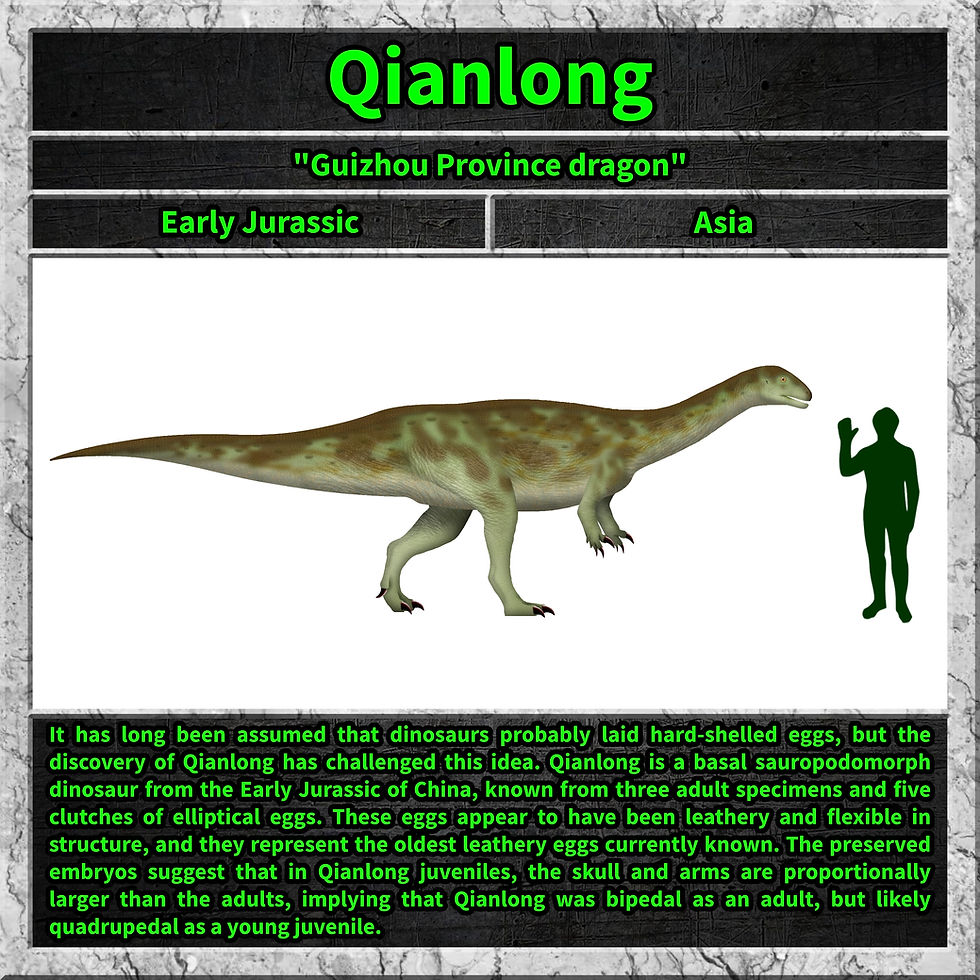Plateosaurus
- unexpecteddinolesson
- Oct 29, 2023
- 2 min read
Updated: Jun 9
MEANING: Broad lizard
PERIOD: Late Triassic
CONTINENT: Europe
Plateosaurus is a basal sauropodomorph, and one of the earliest described dinosaur genera that is still used today. It was a bipedal herbivore with a small skull on a long, flexible neck. It had powerful hind limbs, short but muscular arms, and grasping hands with large claws on three fingers, possibly used for defense and feeding.

Plateosaurus is from the Late Triassic. The Triassic is the first geologic period of the Mesozoic, spanning from the end of the Permian Period 252 million years ago to the beginning of the Jurassic 201 million years ago. Both the start and end of the Triassic were marked by major extinction events. In the aftermath of the devastating Permian-Triassic extinction, life gradually rebounded, giving rise to new groups that would shape the Mesozoic Era. The global climate during the Triassic was mostly hot and dry, with vast deserts dominating the interior of the supercontinent Pangea. Over time, as Pangea began to rift apart, the climate slowly became more humid, creating new environments and opportunities for ecological diversification.
For much of the Triassic, dinosaurs were not yet the dominant terrestrial animals. Instead, the land was populated by a variety of other reptiles, including sprawling archosaurs. Early synapsids, the lineage that would eventually lead to mammals, were also still present but declining. Vegetation was dominated by drought-tolerant plants such as seed ferns, cycads, ginkgoes, and early conifers. These hardy plants formed the base of recovering ecosystems during this volatile time.
It wasn't until the Late Triassic, around 230 million years ago, that the first true dinosaurs appeared. Early forms were small, bipedal, and lightly built, likely preying on insects and small vertebrates. While they remained minor players compared to other reptilian groups, their agility, upright stance, and efficient breathing gave them advantages that would prove crucial in the long run. As the Triassic drew to a close, another mass extinction event reshaped life on Earth once again, wiping out many of the dominant reptile groups and clearing the way for dinosaurs to rise to prominence in the Jurassic.

Plateosaurus is a sauropodomorph. Sauropodomorpha is a group long-necked, herbivorous, saurischian dinosaurs that includes the sauropods and their ancestral relatives. Sauropods generally grew to very large sizes, had long necks and tails, were quadrupedal, and became the largest animals to ever walk the Earth. The prosauropods, which preceded the sauropods, were smaller and often able to walk on two legs. The sauropodomorphs were the dominant terrestrial herbivores throughout much of the Mesozoic Era, from their origins in the Late Triassic until their extinction at the end of the Cretaceous.
Sauropodomorphs had a light, tiny skull on the end of a long neck and a counterbalancing long tail. These adaptations gave them access to high tree foliage. The earliest known sauropodomorphs were small and slender, but by the end of the Triassic, they were the largest dinosaurs of their time, and throughout the Jurassic and Cretaceous they continued growing. They were initially bipedal, but as their size increased they evolved a four-legged gait adapted only to walking slowly on land. The early sauropodomorphs were most likely omnivores as they were only recently diverged from the carnivorous theropods.




